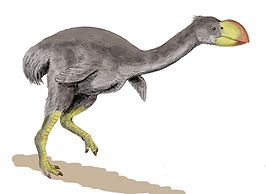Researchers have learned more about the delayed breeding behaviors of the extinct “thunder bird,” or dromornithid, thanks to the discovery of large bones in the northern Flinders Ranges and close to Alice Springs.
Vertebrate paleontologists at the University of Cape Town (UCT) and Flinders University have studied the microstructure of these giant Australian fossil bones and concluded that the animals’ size and breeding cycle changed gradually over the millennia but ultimately couldn’t keep up with environmental changes.
The study, published in The Anatomical Record, compares the skeletons of the oldest and largest mihirung Dromornis stirtoni, which lived 7 million years ago and stood up to 3 meters tall and weighed up to 600 kilograms, to the smallest of the flightless birds, Genyornis newtoni, the last species of mihirung, which lived alongside early emus, now the world’s third-largest bird.
Research suggests that it took the world’s largest bird, Dromornis stirtoni, up to 15 years to reach full adult size and sexual maturity. Genyornis newtoni lived in a considerably drier climate with greater seasonal variation and unpredictable droughts throughout the late Pleistocene. These birds, which eventually reached a size six times that of an emu and weighed around 240 kilograms, matured far more quickly than the original mihirung, perhaps in just a year or two, and began reproducing almost immediately.
In comparison to practically all modern birds, which achieve adult size in a year and can reproduce in the second year of life, their growth technique was still extremely slow because it took them many more years to attain adult body size.
The reproductive biology of the late Pleistocene dromornithids shows that they were breeding earlier than their forebears in response to ever-changing climate stresses, although this strategy did not come close to the reproductive efficiency displayed by giant ratite birds today. In about a year or two, emus reach sexual maturity and can start producing offspring. The ability to quickly reproduce after a food or water deficit helps these populations recover quickly when conditions improve.








